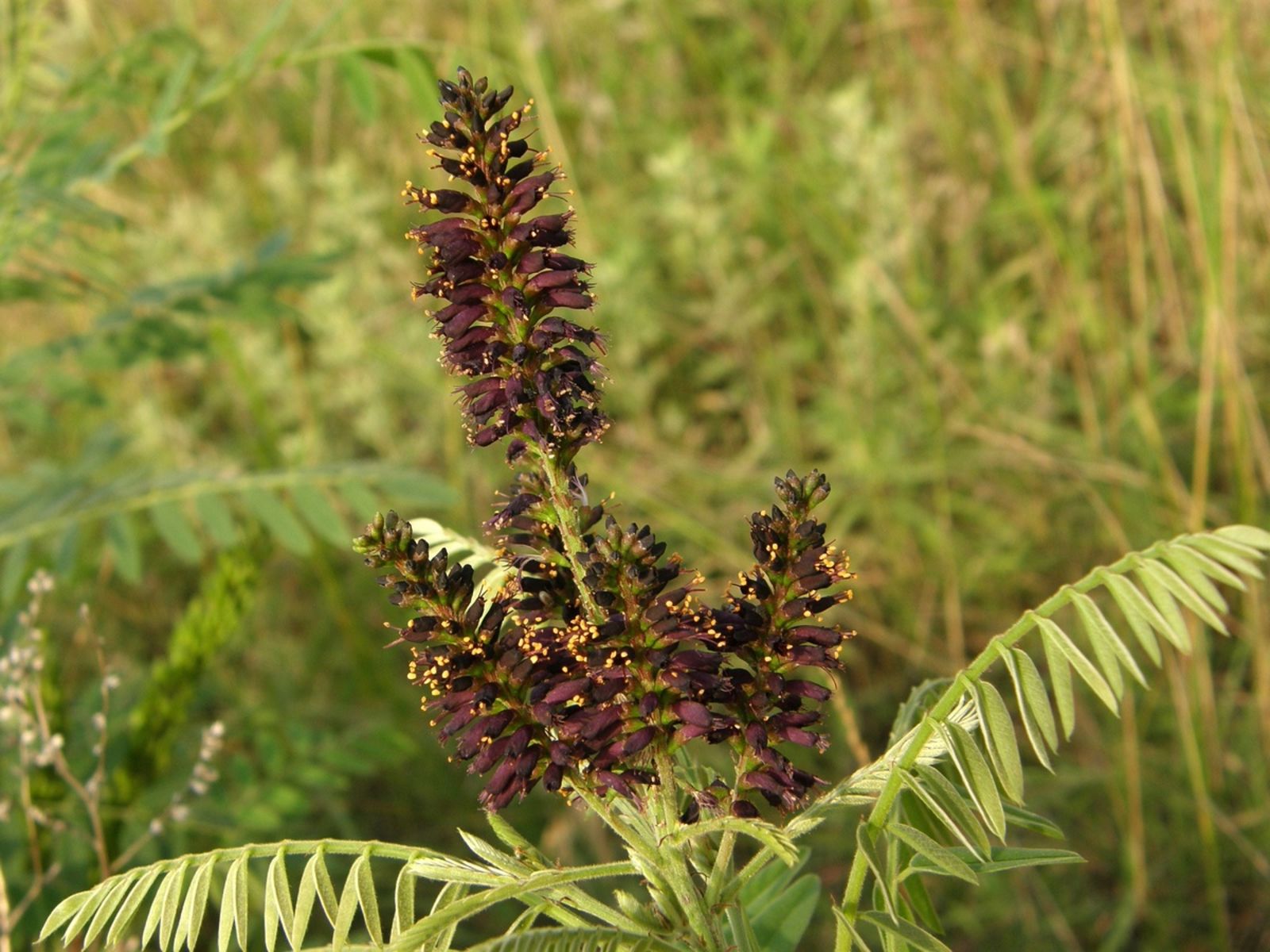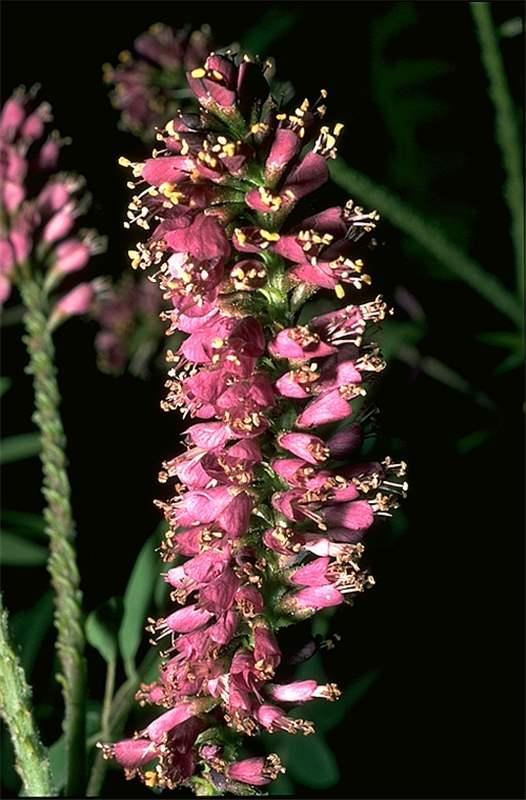Indigo Bush
amorpha fruticosa
Also known as: ["False Indigo Bush","Desert False Indigo"]
Overview
A deciduous shrub native to North America, known for its feathery purple flowers and nitrogen-fixing capabilities.
Benefits & Perks
["long-flowering","wildlife attractant (bees, butterflies, birds)","drought tolerant","shade tolerant"]
Botanical Classification
| Phylum: | Magnoliophyta |
| Class: | Magnoliopsida |
| Order: | Fabales |
| Family: | Fabaceae |
| Genus: | Amorpha |
| Botanical Name: | Amorpha fruticosa |
Plant Characteristics
Basic Information
- Category: Shrubs
- Suitable Location: mixed shrub border or naturalized area
- Suitable For:
- Is Weed: No
- Allergenicity: low
Environmental Needs
- Climate: {"temperatureRange":"–34–38°C"}
- Hardiness: {"zones":"3–9"}
- Misting: rarely required
- Drainage: Moderate to fast-draining; avoid waterlogged conditions.
- Soil Type: Adaptable to various soils but prefers loamy, fertile, well-draining soil; tolerates poor, sandy, or clay soils.
Maintenance Level
- Maintenance Level: moderate
- Toughness Level: high
- Pruning Frequency: Annually in late winter or early spring; light pruning can be done after flowering if needed.
- Pruning Intensity: Moderate; remove up to one-third of old growth if plant is overgrown; otherwise, selective thinning.
Care Details
Ideal Sunlight Coverage:
Full sun (6–8 hours of direct sunlight daily); tolerates partial shade but may become leggy.
Sunlight Tolerance Tips:
Acclimate plants gradually to intense sunlight; protect from harsh afternoon sun in hot climates; ensure adequate spacing for light penetration.
Care Requirements
Care Difficulty
moderatemoderate
Sunlight
full sun to partial shade
Monitor for leaf scorch; rotate plants for even light exposure; use shade cloth if needed in extreme heat.
Watering
every 7–10 days during active growth, less frequently in winter
Water thoroughly but infrequently to encourage deep root growth; ensure soil dries slightly between waterings; avoid waterlogging.
Soil
well-drained, sandy or loamy soil
pH: Adaptable pH range (6.0–7.5); tolerates slightly acidic to slightly alkaline conditions.
Ensure good drainage; amend with compost annually; avoid compacted soil.
Temperature
Hardy in USDA zones 3–9; tolerates temperatures from -30°F to 100°F; prefers moderate temperatures for optimal growth.
Protect from frost in early spring; water early to avoid heat stress; adjust care based on seasonal extremes.
Fertilizing
every 4–6 weeks during spring and summer
Fertilize sparingly; avoid fertilizing stressed plants; apply fertilizer to moist soil to prevent root burn.
Propagation
Methods
Softwood or semi-hardwood cuttings; division of established clumps; seeds (though germination can be slow and erratic).
Step-by-Step Propagation Guide
- Take cuttings in spring.
- Apply rooting hormone.
- Plant in medium.
- Maintain humidity.
- Transplant once rooted.
Best Time: Late spring to early summer for cuttings; early spring for division; autumn for seeds (stratification may be needed).
Environment
Warm (70–75°F), humid environment with indirect light; protect from drafts.
Medium
Well-draining potting mix (e.g., peat and perlite) or vermiculite for cuttings; moist seed starting mix for seeds.
Hormone
Rooting hormone recommended for cuttings to improve success rate.
Timeline
Cuttings may root in 4–8 weeks; division is immediate; seeds may take several months to germinate.
Tools Needed
Pruning shears, rooting hormone, pots, misting spray bottle, heating mat (optional).
Quick Tips
Use healthy, disease-free cuttings; maintain consistent moisture; provide bottom heat for faster rooting.
Pruning & Repotting
Pruning Guide
Method
Thinning cuts to open the canopy; heading back to reduce height; selective removal of weak or crossing branches.
Pruning Plan
Prune to maintain shape, encourage bushier growth, and remove dead or diseased wood; also to control size in smaller gardens.
Tools
Pruning shears, loppers, saw (for larger branches), disinfectant (e.g., rubbing alcohol).
Checklist
Disinfect tools; prune during dormancy; make clean cuts; remove dead/diseased wood first.
Repotting Guide
Best Season
Early spring before new growth begins; avoid repotting during flowering or extreme weather.
Pot Size
Increase pot size by 2–3 inches in diameter; ensure drainage holes are clear.
Method
Gently remove plant; trim any circling roots; place in a slightly larger pot with fresh, well-draining soil; water thoroughly.
Suggestions
Not typically required for outdoor plants; container-grown plants may need repotting every 2–3 years if root-bound.
Checklist
Choose appropriate pot; prepare new soil mix; handle roots carefully; water after repotting.
Advanced Care Tips
Watering Mastery
Watering Checklist
Check soil moisture before watering; water deeply; ensure proper drainage; adjust frequency seasonally.
How to Apply Water Properly
Water at the base of the plant, targeting the root zone; apply until water begins to drain from the bottom; avoid wetting foliage to prevent fungal issues.
Watering Schedule Tips
Water deeply once per week during spring and summer; reduce frequency to every 2–3 weeks in fall and winter. Adjust based on rainfall and soil moisture retention.
Soil Improvement
Add organic matter (compost) to enhance fertility and structure; incorporate sand or perlite for drainage in heavy soils.
Temperature Stress Management
Signs of Temperature Issues
Chlorosis or leaf drop in extreme heat; stunted growth or dieback in prolonged cold.
Cold Stress
Leaves may wilt or turn brown; growth slows or halts; roots can suffer damage in poorly drained soil during freeze-thaw cycles.
Solution: Mulch heavily around the base; avoid overwatering before cold snaps; provide wind protection in exposed areas.
Hot Stress
Wilting, leaf scorch, or premature flowering; reduced vigor and susceptibility to pests.
Solution: Water deeply during heatwaves; provide afternoon shade; increase air circulation around the plant.
Fertilizing Guide
Fertilizing Checklist
Use balanced fertilizer; apply in spring; avoid late-season feeding; follow package instructions.
Fertilizing Method
Use a balanced, slow-release fertilizer in early spring; avoid high-nitrogen formulas; reduce or stop fertilizing in late summer/autumn.
Common Problems & Solutions
Toxicity Warning
Cats
ToxicCats are highly sensitive to the toxic compounds in Amorpha fruticosa. Ingestion can result in severe gastrointestinal upset and neurological symptoms, potentially leading to serious health complications.
⚠️ Symptoms:
🌿 Toxic Parts:
⚡ Toxic If:
if eaten
Dogs
ToxicThe toxic compounds in Amorpha fruticosa can cause severe gastrointestinal and neurological effects in dogs. Ingestion can lead to significant distress and potential systemic toxicity.
⚠️ Symptoms:
🌿 Toxic Parts:
⚡ Toxic If:
if eaten
Humans
ToxicAmorpha fruticosa contains toxic compounds, including quinolizidine alkaloids, which can cause significant physiological disturbances upon ingestion. These compounds interfere with normal cellular functions and can lead to severe health issues.
⚠️ Symptoms:
🌿 Toxic Parts:
⚡ Toxic If:
if eaten
Frequently Asked Questions
Q: Is Amorpha fruticosa toxic to pets?
A: It is mildly toxic to dogs and cats.
Q: Does this plant attract wildlife?
A: Yes, it attracts bees, butterflies, and birds.
Q: Is it drought-tolerant?
A: Yes, it is drought-tolerant once established.
Quick Reference
| Family: | Fabaceae |
| Care: | moderate |
| Light: | full sun to partial shade |
| Water: | every 7–10 days during activ |
Get Expert Care Tips
Download the Plantious app for personalized care reminders and plant identification!
Google Play App Store








